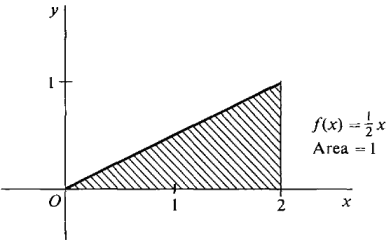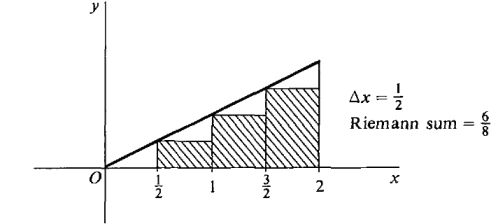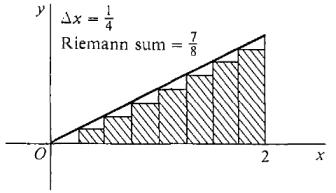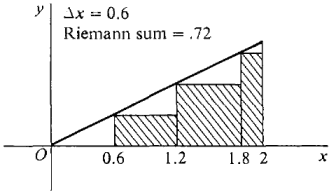| The ebook Elementary Calculus is based on material originally written by H.J. Keisler. For more information please read the copyright pages. |

|

Home  Integral Integral  The Definite Integral The Definite Integral  Examples Examples  Riemann Sum and Area of a Triangle Riemann Sum and Area of a Triangle |
|






|
|
Riemann Sum and Area of a Triangle
Let f(x) = ½x. In Figure 4.1.6, the region under the curve from x = 0 to x = 2 is a triangle with base 2 and height 1, so its area should be A = ½bh = 1.
Figure 4.1.6 Let us compare this value for the area with some Riemann sums. In Figure 4.1.7, we take Δx = ½. The interval [0,2] divides into four subintervals [0, ½], [½, 1], [1, 3/2], and [3/2, 2]. We make a table of values of f(x) at the lower endpoints.
Figure 4.1.7 The Riemann sum is then
In Figure 4.1.8, we take Δx = ¼. The table of values is as follows.
Figure 4.1.8
The Riemann sum is
We see that the value is getting closer to one. Finally, let us take a value of Δx that does not divide evenly into the interval length 2. Let Δx = 0.6. We see in Figure 4.1.9 that the interval then divides into three subintervals of length 0.6 and one of length 0.2, namely [0, 0.6], [0.6, 1.2], [1.2, 1.8], [1.8, 2.0].
Figure 4.1.9
The Riemann sum is
|
|
Home  Integral Integral  The Definite Integral The Definite Integral  Examples Examples  Riemann Sum and Area of a Triangle Riemann Sum and Area of a Triangle |
|
Last Update: 2010-11-26











